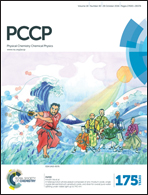Initial dissolution of D2O at the gas–liquid interface of the ionic liquid [C4min][NTf2] associated with hydrogen-bond network formation†
Abstract
We have studied the initial dissolution of D2O at the interfacial surface of the flowing jet sheet beam of the ionic liquid (IL) [C4min][NTf2] using the King and Wells method as a function of both the temperature and collision energy of the IL. The initial dissolution probability of D2O into the IL [C4min][NTf2] was found to follow the general propensity that the solubility of gases into a liquid decreases with temperature. However, a large partial molar enthalpy and entropy for the initial dissolution of D2O in the IL [C4min][NTf2] were observed from the temperature dependence of the initial dissolution probability: ΔHl = −53 ± 8 kJ mol−1, ΔSl = −210 ± 30 J mol−1 K−1. In addition, it was found that the collision energy significantly reduced the initial dissolution probability. We propose that the associated D2O molecules at the interface of the IL [C4min][NTf2] make a hydrogen-bond network around the [NTf2]− anion before dissolution into the deeper portion of the interface layer.
![Graphical abstract: Initial dissolution of D2O at the gas–liquid interface of the ionic liquid [C4min][NTf2] associated with hydrogen-bond network formation](/en/Image/Get?imageInfo.ImageType=GA&imageInfo.ImageIdentifier.ManuscriptID=C6CP03448A&imageInfo.ImageIdentifier.Year=2016)

 Please wait while we load your content...
Please wait while we load your content...